|
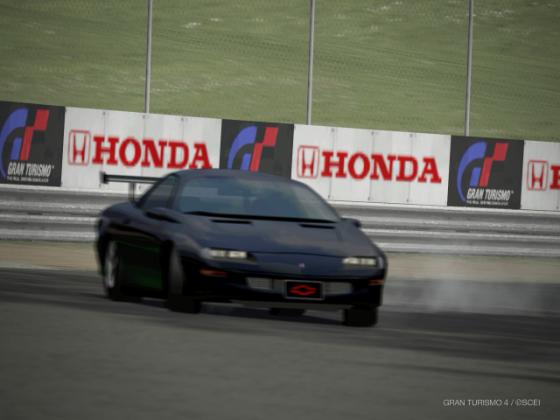
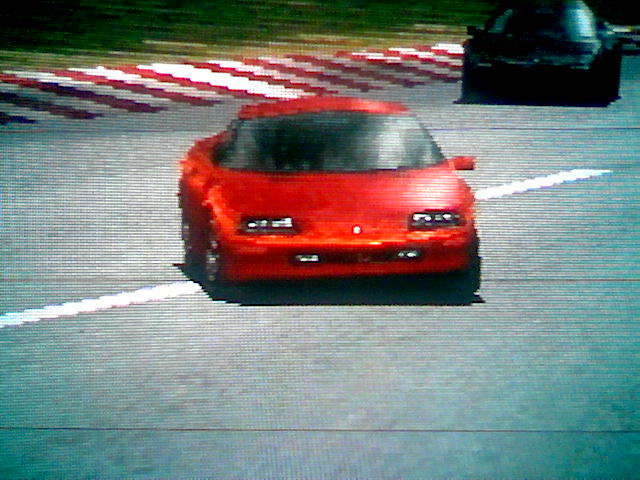
Year: 1996-2001
Class: Muscle Car
Type: 2-door coupe
Country: USA
Host: GT1, 2, 3, 4, & 5
--------------------STATS-----------------------
Price as tested: $24,770 (GT1)
$22,830 (GT2 & GT3)
$12,055 (GT4 used lot)
$16,146 (GT5 used lot)
GT5 Mileage: 4,429.2
Length: 193.18" // Width: 74.1" // Height: 51.3"
Wheelbase: 101.1"
Overhang: 7 feet 7½ inches
Track: 60.7" [F]
60.6" [R]
Ground Clearance: 5.5"
Weight: 3,441 lbs.
Wgt. Dist: 58/42
Layout: front engine / rear drive
Tires:
P245/50ZR-16
F. Suspension: double wishbone / coils / anti-roll bar
R. Suspension: torque arms / trailing links / anti-roll
bar / live rear axle
Brakes: vented discs + ABS
The car in GT5 was not given oil change or engine rebuild
for all specs & testing below.
Engine: 350 cubic inch OHV V8
Aspiration: normal
Fuel System: seq. port fuel inj.
Valves
/ Cyl: 2
Bore x Stroke: 4.0 x 3.48"
Compression: 10.4:1
GT1 Tested HP: ``283 @ 5,000 rpm
GT1 Tstd. Torque: 326
@ 2,500 rpm
GT2 Tested HP: ``290
@ 7,000 rpm
GT2 Tstd. Torque: 325 @ 2,500 rpm
GT3 Tested HP: ``285 @ 5,200 rpm
GT3 Tstd Torque: 325 @
2,400 rpm
GT4 Tested HP: 285 @ 5,200 rpm
GT4 Tstd Torque: 323.89
@ 2,400 rpm
GT5 Tested HP: 282 @ 5,000 rpm
GT5 Tsd Torque: 321 @ 2,500 rpm
Pounds per HP: 12.22 (GT1) // 11.85 (GT2) // 12.07 (GT4) // 12.20 (GT5)
HP per Liter: 49.9 (GT1) // 50.88
(GT2) // 50.25 (GT4) // 48.9 (GT5)
Credits per HP: $87.52 (GT1) // $78.72 (GT2) // $42.30 (GT4) // $ 57.66
GT1 Idle: 500 // Redline: 6,500 // RPM Limit: 8,000
GT2 & 3 Redline: 6,500 // RPM Limit: 7,000
GT4
Idle: 750 // Redline: 5,750 // RPM Limit: 6,500
GT5 Idle: 750 // Redline: 5,700 // RPM Limit: 6,500
Transmission: 4-speed automatic (GT1)
````````````````````6-speed manual (all others)
0-60 mph:
5.9xx seconds (GT1) 5.633 seconds (GT2 & 3)
6.116 seconds (GT4) // 5.716 (drop clutch at redline)
6.063 seconds (GT5)
0-100 mph:
12.633 seconds (GT1)
13.7xx seconds (GT2) // 13.133 (GT3)
14.050 (GT4) // 13.483 seconds (drop clutch at redline)
14.320 (GT5)
0-150 mph:
@32.xxx seconds (GT1)
39.280 seconds (GT4)
49.294 seconds (GT5)
GT1 400 M: 13.910 @ 107 mph GT2 400 M: 14.155 @ 101
mph
GT3 400 M:14.205 @ 99.5 mph
GT4 400 M: 14.497 @ 102
mph
GT5 400 M: 14.598 @ 101 mph
GT5 1/4 Mile: 14.650 @ 102 mph
GT1 1 KM: 25.070 @ 139 mph GT2 1 KM: 26.408 @ 131 mph
GT3 1 KM: 26.143 @ 128.9
mph
GT4 1 KM: 25.890 @ 132 mph
GT5 1 KM: 26.040 @ 129 mph
GT5 1 Mile: 33.973 @ 143 mph
GT2 Test Track: 1:40.205
GT3 Test Track: N/A
GT4 Test Course: 2:20.383
GT5 Daytona Lap: 57.658
GT1 brakes, 100-zero: 3.667 seconds GT4 brakes,100-zero: 4.08 seconds Top Gear RPM @ 60 mph:
1,500 (GT1)
Top Gear RPM @ 60 mph: 1,750 (All other games)
Top Speed at Redline (GT1) 1st:
60 mph 2nd: 116 mph 3rd: 172 @ 6,000 rpm 4th: 171 @ 4,100 rpm
Top Speed at Redline (GT3)
1st: 54 mph
2nd: 79 mph
3rd: 109 mph
4th: 143 mph
5th: 168.80
mph @ 5,750 rpms (GT3)
```````168.50 mph @ 5,700
rpms (GT4)
6th: Nil
GT5 Top Speed at Redline
1st: 47.0 mph
2nd: 69.5 mph
3rd: 95.9 mph
4th: 123.4 mph
5th: 166.5
@ 5,750 rpm
6th: 157 @ 3,600 rpm
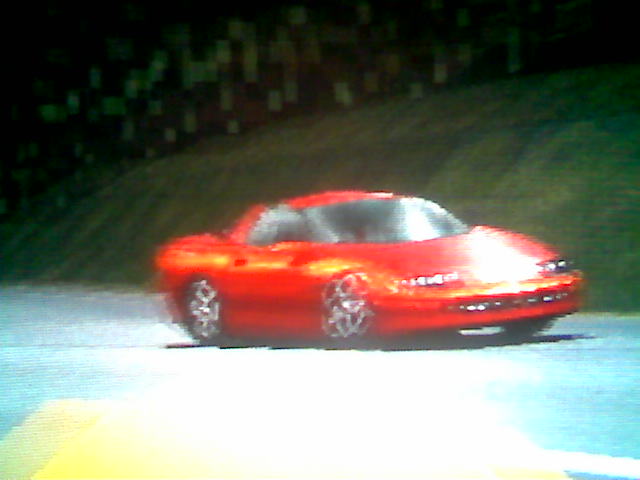
-------------------------EXTERIOR-----------------------
Take a healthy dose of strength, add plenty of oomph, and now mix it with clumsiness and just a tad of ingenuity.
What do we get? Well, what is represented in every Gran Turismo so far: GT1, 2, 3, 4, and 5 are the final years
of 4th gen Camaro Z28s....that's what.
Camaros have long been one of America's default muscle/pony cars along with the Camaro's
main competitor, the Ford Mustang. During the '90s, it was these two models, along with Pontiac's Trans Am and Firebird,
that were the sole remainders ... the only ones left from the '60s, when (of course) there were many more models to choose
from this genre. There have been a few exceptions to this (like the Monte Carlo, which Chevy brought back from the dead) but
it is only the Camaro, Firebird / Trans-Am and the Mustang that have filtered without pause from that golden "who cares"
era, evading gas prices, government restrictions, and front-drive layout changes suffered by many other models.
The best thing about a Camaro, really the main reason to buy one, is that it packs lots of horses
for not much money. But the worst thing? Heh heh, where do we begin folks?!. We'll get to all that later; for now,
I'll focus on the Camaro in as neutral a voice as I can muster. Here's a quick summary of this car's life from game to
game.
• Amongst the cars of Gran Turismo 1, the Z28 (with its rumbly engine) is almost
unique, since most of the cars in the first game have smaller high-revving motors. It's one of very few Americans in
this first GT. What an honor.
• In GT2, the Z28 gets lost amongst a soup of autos that have lots of power and make
plenty of noise--but perform better.
• In the 3rd game, the Camaro is once again a good ‘bang for the credit’
choice, still affordable, and again competes for attention with less other cars. Few would disagree that not many others
match its basic horsepower / credit value, and those that would are just jealous or ridiculous.
• GT4 and GT5: the scenario here is kinda like it was in GT2.
The Camaro Z28 is back to being just one of so many faces. It is also a used car...several thousand credits cheaper
than it was in previous games. It is also a bit rare. Finding one in that perfect color might take weeks or even months! The
newest version of the Camaro SS can be bought from the dealer at any time, though.
Anyways, this is a big car. The Z28 may not be a Lincoln or a Cadillac, but in the
world of GT it's physically one of the larger vehicles. We can see this clearly during replays when racing amongst a
bunch of Hondas and Mazdas. The mere size of the Camaro can become a problem. It's not so much that the car is big;
it's that the body itself is long but the wheelbase isn't. Compare 193 inches of length to a 101 inch wheelbase. Many compacts
and subcompacts have a better approach here!
Basically, there's a lot of overhang towards the front and rear; and though the Z28 looks racy and has gaudy
American features, it's almost useless to drive a stock Z28 through the twisty portions of most any track in GT1.
In GT2, 3, 4, or 5 you may have an easier time during easier races, but just try driving an unmodified Camaro
in the GT1 Normal Series! You won't get far.
All of this accurately reflects reality. Real-life Camaros are made to look good and provide a fast ride
on the highways and streets of America, but they don't do so well with corners if a bit of speed is gathered up. The general
arguement goes: Mustangs handle better than the F-bodies when stock, but the Camaro has more raw power. And this argument
never ceases. Here's some more facts.
• In GT1, full weight reductions are an absolute must if we're ever going to get
a handle on this car's poor handling. Before this, be prepared to learn lots about unwanted power-sliding, oversteer, and
even understeer. Semi-racing tires help, but are below par when it comes to really fast driving. The Z28 can go further
with normal or sports tires in later games, though. Either way, it's still gonna need slicks on this car once the engine
gets Stage 1 tuning, unless the driver is somewhat experienced.
• The car in GT1 is about the same weight as the GT2 Camaro (3,461 pounds vs. 3,441),
but the GT2 car winds up being heavier (3062) than the GT1 car (2,698) once all weight is
taken off. The trade-off is that the car in GT2 DOES wind up having more power on the aftermarket.
• GT3: A-Spec's version can be lightened somewhere between the two previous games (2,935
pounds). GT4 falls even lower (2,854 pounds) with Stage 3 weight class taken care of.
There is a "Camaro Race Car" in GT3 & 4 that can be won, and it can be bought in GT5 from this game's
used car lot. It can accept over 900 horsepower in upgrades in those first two games. I've used it in a handful of Amateur
races with its minimum power of 542...but later on in some of those Pros, it will need all the power that
can be bought. In GT5, it unfortunately gets underdogged with power. In this game it can make just under 700 at best. While
this sounds like a lot, there are a couple championships I really wanted to tackle in this game (GT All Stars is one of them)
and the CRC can win a few of these, but not all of them.
My personal problems with the CRC are:
1). It's one of PD's "fantasy" machines..apparently not based on anything that exists in real-life (I did
lots of exploring to come to this conclusion, folks). This one does not exist as an actual vehicle, although it certainly
could.
2). The Camaro Race Car's exhaust sound SUCKS. A small-block V8 is what one would expect in such a car...instead
PD programmed what sounds like a Miata engine into the CRC, in both GT3 and GT4. Thankfully, it doesn't behave like a Miata
engine. In GT5, we've got what sounds to be a V6, certainly plausible, since V6 Chevy engines have become popular in
some real-life race series.
So to recap: The Chevy dealership sells 4th-generation Z28s in a variety of colors in the first
three games, but in the 4th and 5th game they are now used cars. Oh almost forgot: one can win the 30th
anniversary version Z28 in GT1 or 2. It has a snazzy white and red/orange paint job which commemorates
the Camaro's first year (1967). But there is no mechanical difference between this car and the regular showroom Camaro.
The Chevy Camaro Z28 has its faults, but basic raw power isn't one of them! Let's discuss this now.
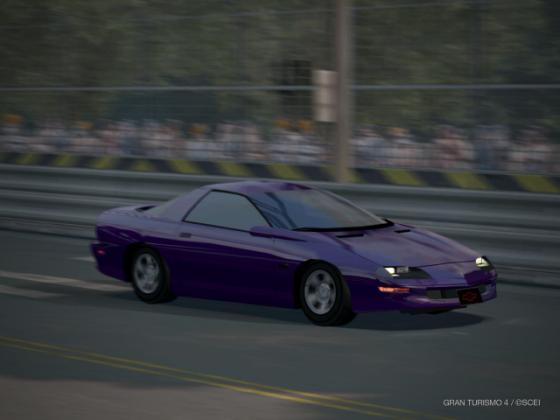
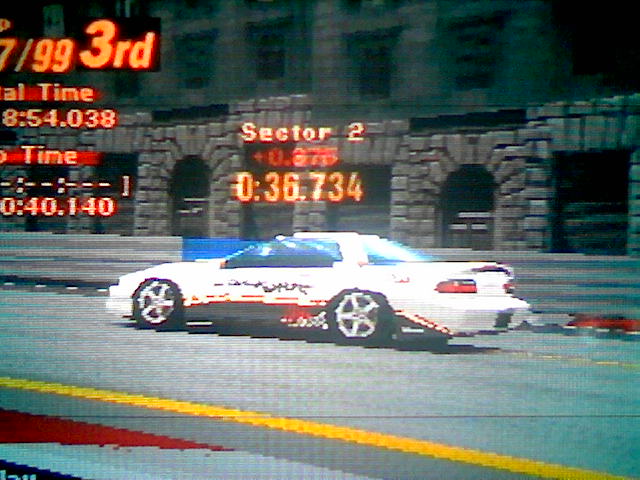
|
| Camaro Z/28 racing kit from GT2. |
----------------------ENGINE / DRIVETRAIN------------------
The Engine? Can't criticize it much. With stock parts, the 350 cubic inch V8 this car is packing has loads
of power that we shouldn't need to modify at all for most beginner events, though it's possible
to do so easily. This engine has lots of natural low and mid-range torque, but can also rev high. Again, let's discuss game
to game...
• Tuning the Gran Turismo 1 car up (there are two levels of NA tuning available)
makes it accelerate up to 4 seconds faster, but won't change the zero to 60 time much. In other words, expect the Camaro to
accelerate faster and faster at tracks with long straights, but not so much at the shorter, more 'technical' ones
(unless gears are also modified). Many people wonder why a Camaro in GT1 can't accept more power when its real-life versions
certainly can. I don't have an answer; perhaps PD was mis-informed somehow. Who knows.
• In the 2nd & 3rd games, Polyphony got wise and allowed three NA tunes--a total
of 624 hp @ 7,600 rpms
with 515 ft-lbs.@ 5,600 is available in GT2 with full upgrades. Now THAT'S more like it! GT3 runs
even higher with 692 @ 5,600 rpms
with 690 ft-pounds! Although independent engine tweakers (real-life) can get power even higher, perhaps PD
modeled their game-car upgrades based on what Chevrolet officially endorses when racing? Again, I'm not sure. I don't
know everything, folks.
• GT4 added a supercharger kit to the expected line-up of three
NA tunes. Ooo-fah! Unfortuantely, Z28s in this game sport just over 500 horses at most. Expensive Stage 3 tuning
rates higher than the supercharger, so if you want more you'll need to get a Camaro SS.
-GT5? Let's
take it back up a bit, PD seems to have agreed. Top tuned power with oil change & engine rebuild comes to...
399
hp @ 5,600 rpm / 403 ft-lbs @ 3,100
Stages 1, 2, and 3 respectively...
434 @ 5,700 / 432
@ 3,200
499 @ 5,800 / 482 @ 3,300
542 @ 5,900 / 517 @ 3,400
Finally, with a supercharger installed (and
all other permanent and non-permanent mods) we are back to GT2/3 days with...
652 @ 5,900 rpm with 680 ft-lbs.
@ 3,400
Oh yeah. That's the power sub-chapter, now let's discuss the gearbox.
As
a manual-shift or an automatic, it is smooth but set waaaaaay too tall if playing GT1 or 2. In these games if you need
to select a gearbox, go for the super-close (semi-racing) version. Stock and close gearing are both too tall
to use realistically during races. Expect to be in 1st gear a LOT when cornering if you use either of these gear boxes.
GT3
and 4 nixed the super-close gears, but stock or Close units can mostly be used in these later
games anyways, since max power is more realistically located mid-range. GT5 allows us a 6-speed close
box, which becomes useful in certain situations, but (again) stock gears will do just fine for about 70 to 80%
of the driving these cars feel comfortable with.
In those three later games, just imagine you've got this huge
man purse (ladies, you can just picture an actual purse, ha ha), packed full of useful stuff, and that's the
350 c.i.d. engine for you. Power is so reliable, we can grab way deep-down into that purse, as if we're searching for
that last quarter for the toll booth. Even in 3rd gear, I'm finding the 350 doesn't mind torque grabs below 3,000 rpms occasionally.
That's some smiley-face torque, there!
Now to the PD/Camaro goofs. Goofs? What goofs?
• In GT1 Polyphony Digital didn't do their homework, and the Z28 has only 5 speeds instead of 6 like
it should. In real-life, the Camaro could have a 6-speed as an option, see, which makes its absence in this game
pertinent. This car will rumble around the track, hitting 3rd gear at the end of some straights. You'll find you'll seldom
need 4th gear and NEVER need 5th, unless the full-racing gearbox is used. For those that are lazy or don't want to
dial-in settings, go with super-close gearing. The Z28 in this game hits peak horsepower unrealistically high at 7,000
rpms.
• In the 2nd game, the Z28 has a 6-speed, but it is still too tall, or at least feels that way. Again,
peak horsepower shows up at higher rpms than it should....higher than it does in real-life.
• GT3 & 4's Camaro for some reason has a lower power band than it does in the first two
games, which is actually (finally) accurate. Peak power is in the 5,000s (2,000 rpm lower than in GT1 and GT2, oddly)
so 4th and 5th gear become useful at longer tracks. 6th will only see action if the Z28 is super-powered, and
rolling round the Test Course or some other such area with super-long straight portions.
So let's talk about the power-band, and how it varies from game to game.
If you've been racing little 4 or 6-cylinder economites around, the Camaro's old-fashioned overhead-valve
V8 can be a bit of a bear to handle. As mentioned, in the first two games this engine likes to be shifted only when
revs are high. Even though max HP should be created in the 5,000-6,000 rpm range (in real-life), if you shift anywhere
below red-line, you'll be stuck with an engine that is revving too low, as the car loses some speed (assuming gearing is still
stock).
Now in GT3 and 4/5, the power-band, torque curve, and redline are more realistic. Manual-transmission drivers
can let the tach drift slightly into the redline area before needing to shift ... but it's not necessary to
go all the way to 7,000 rpms to get the best range, the way we did in GT1 and 2!
If racing slicks are on, it's also advisable to rev the engine high at the start of a standing-start
race. Those slicks + all the weight in the back of the car will provide plenty of traction, so there will
be not as much wheel-spin as can be encountered with stock or sport tires.
Again, ignore this for the 3rd game! In
fact, some folks may find the Camaro incredibly tail-snappy in GT3, and they may need to turn the traction controller on.
But not me. Oh no. ;)
In GT4, launching a Camaro when stock is easily done (even on N3s), but as power gets added with
just a Stage 1 NA kit, standing-start accleration runs will have to be seriously tamed. During races, however,
the rear-end plants itself extremely well, excessive oversteer is rare unless there is alot of power or a bad tire
combination.
Unlike GT4, GT5's Camaro allows a bit of smokey wheelspin in 1st gear at times, especially on the car's
stock Comfort Soft radial tires. If you want to pretend you're back in GT4/2004, there's the ability to use a little less
throttle to avoid this during straight-line runs, but when cornering this is another story. More on that during the
Handling section.
All in all, expect to spend more money on the suspension, tires, and brakes than you will on the engine
and drivetrain in the early stages of this car's development. Here's why.
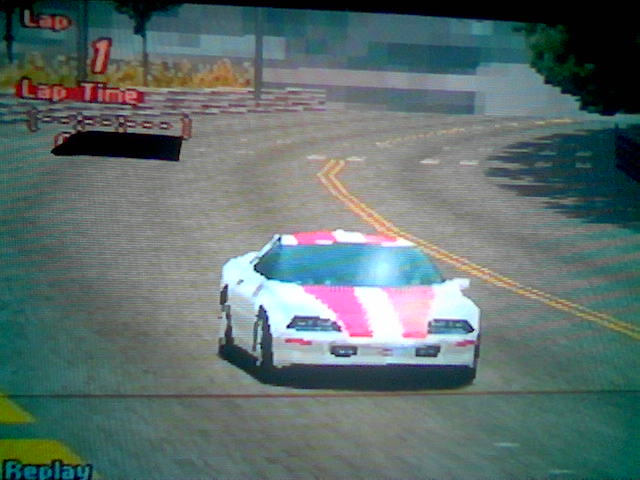
|
| 30th Anniversary Camaro can be won in both GT1 and GT2. |
---------------------CHASSIS / HANDLING--------------
Remember these words. The engine is great, but the handling this car displays can be
an absolute HORROR at times.
Back when I was a budding driver, honing my skillz, I tried racing this car in the GT1 Normal competition
and actually dropped out because the Z28 handles so badly. It's a shame, too, since the engine has enough power
to keep up with the competition.
GT1:
If you seriously want to drive this car, even in the lowly Sunday Cup series or spot races, you'll have
to tweak the suspension and change those tires; otherwise, body lean and poor traction will have you possibly doing
donuts and spinning out all over the place---especially if you're not modulating the throttle enough. Most newbies (myself
included at the time) tend to want to mash the gas! Not recommended in those tight areas. More experienced drivers might be
able to avoid most of this.
It can be embarassing; even some of the weaker computer cars will laugh at a stock Camaro in GT1. If you
race it carefully...braking early and getting under control before corners, you won't be able to get as much speed up before
having to brake early again and face being blown away by a more nimble Starlet or Demio!
Now in GT2, 3, 4,
there isn't such a rush for better handling early on because Camaros can be entered in an assortment of events that are truely
easy. In any of these games, a sports or semi-racing suspension will keep this car running more competitively--racing parts
only become necessary later when you're getting rich & fat. Sports tires or sometimes even normal (stock) tires can be
used.
....Still, problems persist...mostly understeer, while the car is stock or near-stock. Odd diving behaviour
under braking (due to all that body overhang I was talking about earlier) also creates awkward cornering dilemmas which
will constantly need to be addressed. Add fishtailing and other typical RWD oversteer issues as power gets raised.
Camaros naturally have soft, wimpy springs. Kind of a shocker. The car in GT1 supports a watery 2.2 kg/mm
front and back. In later games it is a little more highly sprung, but not up to Supra levels where it should be to live up
to its "sporty" status. The reason is: most real-life Camaro customers don't actually want to road race,
they just wanna bite pavement when the light turns green. Cornering isn't so important. They want
to go fast in a relatively straight line, basically, just like they're at a drag race. In our game, once the suspension is
tweaked and the tires upgraded, the car handles better, but you'll still need to baby it through some corners.
GT5
In this game, PD starts
us off with "Comfort Soft" tires, the equivalent to real-life warm weather radials. In this game, the Z28 feels like no other.
We really can't always rush for better tires, because the stock ones are so fun. Why?
Oversteer
is back! Largely missing for many years, oversteer in a stock Camaro Z28 is back for our driving
pleasure. During GT3 and 4, this car's rear became more sanitized, as PD was for whatever reason treating this car like
a baby bicycle with training wheels! Well that nonsense is over. Drop that throttle out of many a corner in 2nd gear
(sometimes 3rd), and that live rear axle responds. Could be just a twitch, could be a massive burnout. Something
is always going on back there, if you want it to. For those that don't want this behavior, there isn't much lift-off oversteer,
unfortunately. Not until Sport tires are installed, anyways.
In original GTs, the rear would get into some vague oversteery
swipes with a lot of safety zone attached. You could get sideways in this car, but the PS1's capabilities for handling
characteristics were limited. Well in GT5, there's now A LOT of behaviors to explore in this car as it gets sideways,
drifts (yes, I said drifts!) with ease, and generally drives with much more passion and excitement
than it ever did in earlier games.
Careful though! For the other part of this car's cornering heritage
is still with us. Yes, that's right: understeer. Just as much understeer as was in GT4. The Z28's braking
ability in GT5 feels at its least confident, matter of fact. Granted, I'm still driving on Comort radial tires,
but this behavior is also true (to a lesser degree) with Sports. The car is incredibly stable under braking, but lots
and lots of time and distance must be needed to slow this beast. The good news is: when understeer does start happening,
the front tires won't always immediately overheat. This car's front tires can tolerate quite a bit of abuse actually before
they'll turn red. This is truer of Sport tires than it is with radials, of course.
Brake early,
and there's still lots of possible issues to avoid. A vaguer mid-corner understeer can still show up, for instance.
Out of corners, one must be more cautious with that throttle than he may have been in GT3 or GT4. Other than some managable
drifty oversteer, the car is not at all tossable in GT5, no surprises here. It often feels as heavy as it is. Giving
a little too much gas in 2nd gear out of a turn? The Z28 often feels like a body builder who's almost lost his balance; the
car getting a little twitchy. It's got the power to get going, but it's also not as refined as some other rear-drive
cars with similar power.
True in real-life for sure. I've driven a couple real-life Z28s from this generation,
matter of fact I did so while I was at work...far away from work, where nobody could see me! They do indeed have the strength,
but these are still muscle cars.
Of course, those of us who are masters, those of us who can figure out how to handle a Z28, can
get some action going. And all those maneuverability and handling faults will eventually fall to the wayside as we learn to
get this hefty beast ready for that next corner....the way it should be!
-----------------------PROS----------------------
1). Lots of power & torque is standard equipment. Excellent off-the-mark acceleration
as well as 165+ mph around the Test Track, completely stock.
2). Relatively inexpensive for a performance car. Some of the best credits to raw horses an armchair racer
can buy. I've seen used Z28s go as low as $8,500 in GT4.
3). Throaty, deep-sounding engine. In GT1, only the Viper, Corvette, and Camaro share these bassy tones
amongst a sea of 4 and 6-cylinder engines.
4). Lots of power options, especially in GT2 & 3, 4, or 5. Cars in GT4/5 can be supercharged as
well as naturally hopped-up.
5). Engine powerband wide and useful 80% of the time! It took PD a couple tries, and they finally got it
right in GT3.
6). We aren't just limited to a handful of shades; GM lays out the palette book for this model.
7). The Camaro Race Car may be somewhat of a genericar, but it goes places never dreamed of by the regular
Camaros (even race-modded versions) in the first two games because of the improved chassis and engine upgrades.
8). Race kits available in GT1 and 2. Possible to win the 30th anniversary Camaro Z28 in these games, too.
-------------------------CONS-----------------------
1). Stock tires can't handle the racing quest Gran Turismo has set for us, even BEFORE the engine has been
modded. Newbies beware. Understeer terrorizes us in all games, along with poor maneuverability at any given technical
course.
2). Add typical oversteer issues in GT1, 2, or 5.
3). There are bed mattresses that have better coil springs in them!
4). Unwieldy brakes / difficult car to slow into corners. Controller is often needed before some of us have
the credits to spend on it. Learn to brake EARLY in most of your Z28 forays...even in the lofty Camaro RC.
4). Long body + short wheelbase make for lots of unwanted weight transfer and difficult maneuverability.
5). Gearing is tall and sometimes too ponderous to use effectively on twisty sections of tracks, especially
if you've got an automatic (this is more true in the first 2 games than it is in later ones).
6). Easily prone to spin-outs in some situations, clumsy behavior. You'll get it all here, step right up.
Not a car for amateurs.
7). GT1 and 2 goofed up the power band, making peak power available at or past 7,000 rpms. Not at all where
the real-life car's power falls. This actually hurts the engine's abilities.
8). The Camaro Race Car. I loved it at first, but now I have so many issues with it. It sounds horribly
unrealisitic (for what is supposed to be an American V8). Secondly, it's too much of a fantasy-mobile. There are plenty of
actual real-life Camaro racing cars this one could have been modeled from.
9). GT4 & 5: the Z28 has become a used car, and isn't always available for sale, which means finding
one may take awhile. Finding one in the color you crave may take even longer.
10). The bulgey, bloated shape of the '90s-era Camaro is an acquired taste! Earlier 1st thru 3rd-gen Camaros
had an "aggressively ugly" look about them as well, but at least they turned enough sales that GM wasn't forced to drop the
entire Camaro line-up as they did in 2003.
Published: May or June of 2004
Editied: various times between 2004 and 2009
GT5 content added: sometime in February 2011
|

